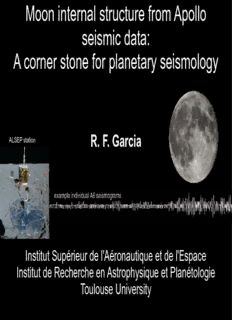
Moon internal structure from Apollo seismic data PDF
Preview Moon internal structure from Apollo seismic data
Moon internal structure from Apollo seismic data: A corner stone for planetary seismology R. F. Garcia ALSEP station Institut Supérieur de l'Aéronautique et de l'Espace Institut de Recherche en Astrophysique et Planétologie Toulouse University Outline Apollo seismic experiments ● Constraints on internal structure from top to ● bottom Sub-surface ● Crustal structure ● Mantle and deep structures ● Other geophysical constraints ● Hot debate : structure of the lowermost mantle ● Preparing new observations ● ALSEP experiment 7 years of continuous recordings ● Very good sensors but poor A/D converters ● Very limited bandwidth (0.3-1.2 Hz), strong scattering ● 15 17 11 12 14 16 ALSEP experiment 7 years of continuous recordings ● Very good sensors but poor A/D converters ● Very limited bandwidth (0.3-1.2 Hz), strong scattering ● Temporary experiments + gravimeter (Apollo 17) ● 15 17 11 12 14 16 Kawamura et al., 2014 Lunar quake zoology 5 Lognonné & Johnson, 2007 Sub-surface exploration by seismic studies Recent re-processing by passive monitoring ● methods → 2 meters of fine dust at Apollo 17 site Larose et al. (2005) Sub-surface exploration by seismic studies This layer appears ● below all the ALSEP seismic stations, but Significant variations ● betwen the stations Large uncertainties in ● the first meters due to bandwidth and resolution of Apollo seismometers. Horvath et al. (1980) Sub-surface exploration by seismic studies Apollo 17 deployed an active a small scale ● seismic network → meter scale dust layer with very low seismic velocities Cooper et al. (1974) Crust Structure (below Apollo Stations) Mainly constrained from direct phases ● Single SP conversion below S12 (Vinnick et al., ● 2001) Chenet et al. (2006) Crust Structure (below Apollo Stations) Average crustal thickness of 28 km ● Strong lateral variations consistent with gravity ● data Beyneix et al. (2006) Chenet et al. (2006)
Description: